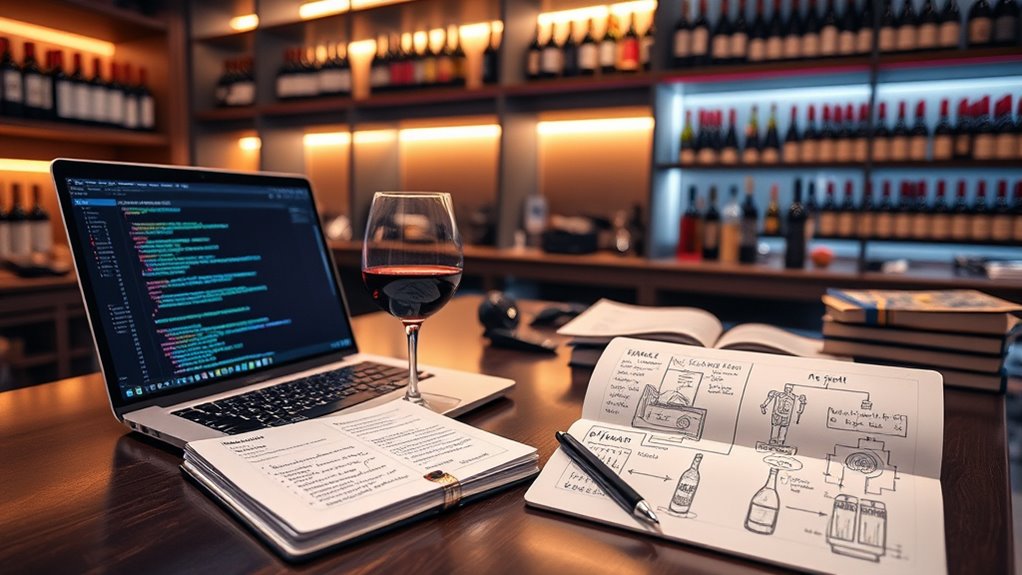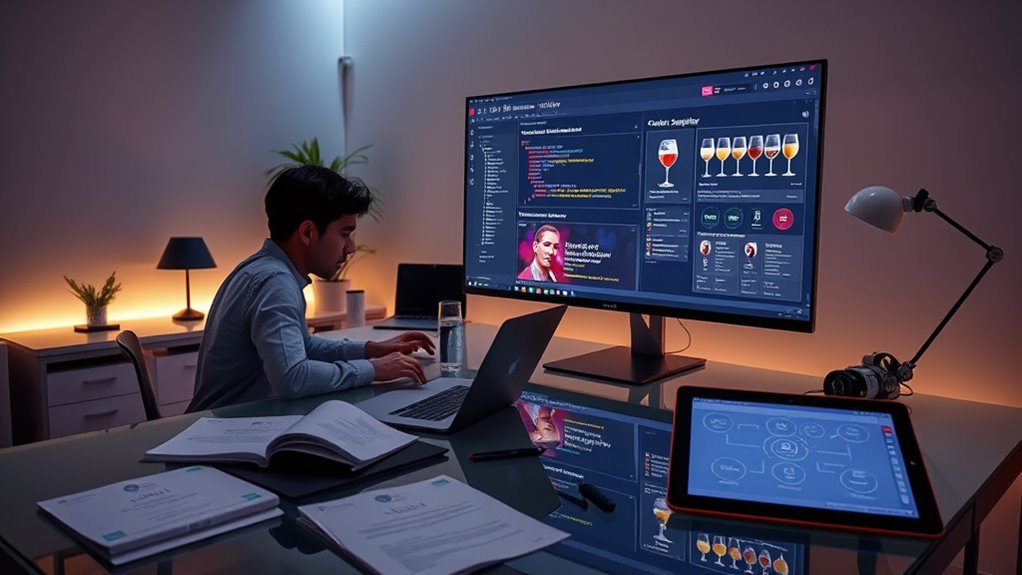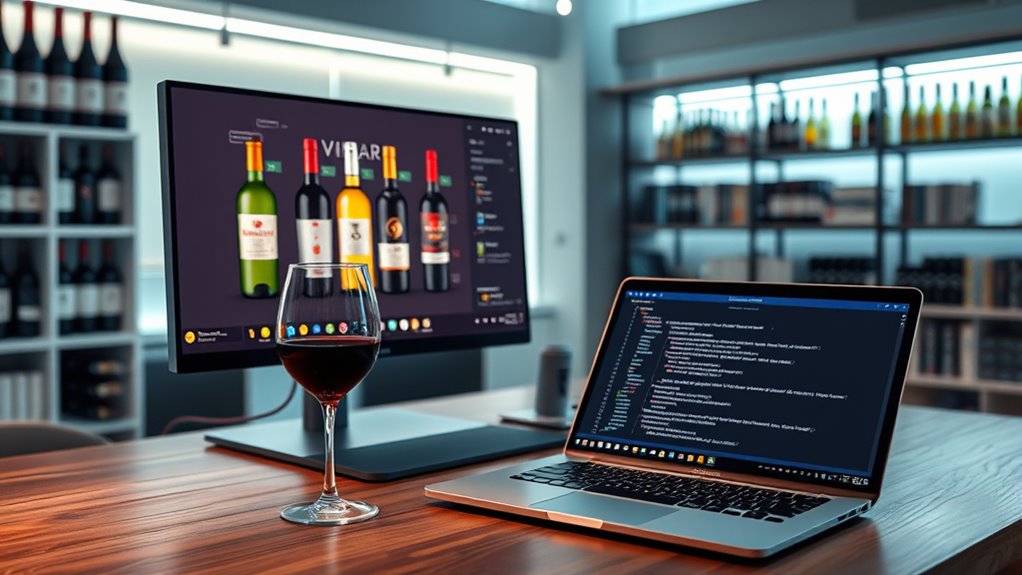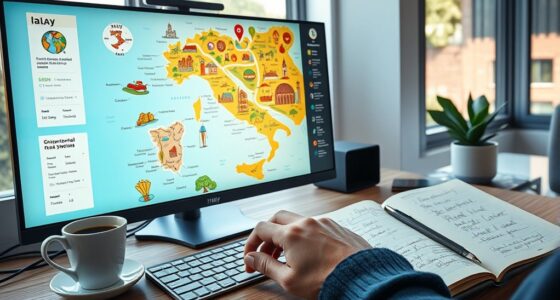To build a chatbot sommelier with open-source models, you start by choosing a suitable model like GPT or BERT that can handle wine-related queries. Next, curate a detailed dataset on wine pairing, regions, and varietals, then fine-tune the model for personalized responses. Proper integration and ethical considerations ensure a trustworthy experience. Keep experimenting and refining your system—if you want to master creating a knowledgeable wine guide, there’s plenty more to explore ahead.
Key Takeaways
- Select and fine-tune open-source models like GPT or BERT using curated wine datasets to ensure domain-specific knowledge.
- Collect comprehensive, high-quality datasets on wine types, regions, pairing principles, and vineyard insights for effective training.
- Implement ethical AI practices, including bias mitigation, transparency, and secure data handling, during model deployment.
- Optimize model performance through iterative testing, validation, and adaptation based on user interactions and feedback.
- Integrate the chatbot seamlessly via APIs or SDKs, ensuring compatibility across platforms for real-time wine-related assistance.
Understanding the Foundations of Open-Source AI Models

Open-source AI models have become essential tools in developing customizable and transparent applications. With open-source models, you gain insight into how the algorithms work, promoting model transparency. This transparency helps you understand decision-making processes, which is vital for building trust with users. Additionally, open-source models encourage ethical considerations by allowing you to identify and mitigate biases or unfair outputs. You can modify these models to align with ethical standards, ensuring responsible AI deployment. Since the source code is accessible, you’re better equipped to audit, improve, and adapt the model for your specific needs. This openness fosters accountability, making your chatbot more reliable and trustworthy. Moreover, understanding the materials used in model development enables you to select or modify models with a focus on safety and effectiveness. Staying informed about latest advancements in AI research also allows you to incorporate cutting-edge techniques that enhance your application’s performance. For example, understanding the training data quality can significantly impact the reliability of your AI model. Additionally, awareness of AI security vulnerabilities helps you implement safeguards against potential exploits. Overall, understanding these foundations empowers you to create AI solutions that are both effective and ethically sound.
Selecting the Right Model for a Wine Chatbot

Choosing the right model means balancing its capabilities with its limitations to meet your wine chatbot’s needs. You’ll want to take into account how well it handles wine-related questions and whether it can be fine-tuned for more specific expertise. Making the right choice ensures your chatbot provides accurate, helpful recommendations to users. Additionally, understanding best of luck wishes can help tailor your chatbot’s responses to foster positive and encouraging interactions. Considering the safety features of certain models may also be beneficial to ensure reliable and secure operation. Evaluating models’ tuning options, such as fine-tuning capabilities for specialized knowledge, can further improve your chatbot’s performance in the wine domain. Incorporating models that understand the nutritional value of juices can enhance your chatbot’s ability to discuss complementary topics like beverage pairings and health-conscious recommendations.
Model Capabilities and Limitations
Selecting the right model for a wine chatbot requires understanding its capabilities and limitations. Open-source models vary in how well they handle cultural nuances and support brand personalization. To choose wisely, consider these factors:
- Language understanding: Can it interpret complex wine-related questions and cultural references? Cultural sensitivity is crucial for engaging users authentically. For example, recognizing regional wine traditions can lead to more accurate recommendations. Incorporating mindfulness strategies can also help in tuning the model to better recognize subtle cultural cues.
- Context retention: Does it maintain conversation flow to personalize recommendations? This helps create a seamless user experience.
- Cultural sensitivity: Is it adept at recognizing cultural nuances in wine preferences? Being aware of regional wine traditions enhances authenticity.
- Customization potential: Can you adapt it to reflect your brand’s voice and style? Tailoring the model ensures it aligns with your branding goals. Incorporating regional diversity can further improve relevance and user engagement.
Additionally, assessing a model’s ability to incorporate cost and budgeting strategies can be beneficial for maintaining an organized and efficient system. Knowing these limitations helps you set realistic expectations and select a model that aligns with your goals. While some models excel at language comprehension, others might need additional tuning to truly capture cultural nuances and brand personality.
Fine-Tuning for Specificity
To guarantee your wine chatbot delivers accurate and personalized recommendations, fine-tuning the model for specificity is essential. You can achieve this by applying personalization techniques that focus on your users’ preferences and wine knowledge. Incorporate user feedback regularly to identify gaps and refine the model’s responses. Fine-tuning allows the model to better understand wine terminology, tasting notes, and pairing suggestions, making interactions more relevant. Start with a base open-source model and adapt it using specific datasets related to wines, regions, and varietals. Continuously update the model based on user interactions to improve accuracy over time. This tailored approach assures your chatbot offers expert advice and a seamless, personalized experience for every user. Additionally, integrating domain-specific terminology related to wine bedroom decor and ambiance can help create more engaging and contextually appropriate interactions. Applying iterative processes from design thinking can further enhance your model’s adaptability and responsiveness to evolving user needs. Incorporating feedback loops into your development cycle helps maintain high-quality recommendations. Incorporating Grocery Savings Strategies into your dataset can also provide users with helpful tips alongside wine recommendations, creating a more comprehensive experience. Moreover, leveraging insights from fan culture can inform engaging ways to connect with enthusiasts and foster loyalty.
Preparing and Curating Wine-Related Data Sets

You are trained on data up to October 2023 and have access to a wide range of chemical and scientific concepts. Incorporating data on electric bike conversion kits can provide insights into innovative components and technological advancements relevant to the field. Understanding technological innovations in related areas can also inform the development of more sophisticated and interactive wine-related datasets. Additionally, exploring cross-disciplinary health and nutrition concepts can inspire novel approaches to data curation and user engagement strategies. Emphasizing the importance of product safety and efficacy can further enhance dataset quality and user trust.
Developing and Training Your Chatbot Sommelier

Once you’ve curated an exhaustive wine-related dataset, the next step is to develop and train your chatbot sommelier. Focus on teaching it to understand wine pairing principles and vineyard management insights. Use open-source models like GPT or BERT to fine-tune with your data, guaranteeing it learns contextual nuances. To make training engaging, consider this table:
| Step | Action | Goal |
|---|---|---|
| Data Preparation | Clean and structure datasets | Clear, relevant info |
| Model Selection | Choose suitable open-source models | Effective language understanding |
| Fine-tuning | Train models on wine pairing, vineyard data | Improve accuracy and relevance |
| Testing | Validate responses with real questions | Ensure quality and consistency |
| Deployment | Prepare for integration | Ready for user interactions |
This process sharpens your chatbot’s ability to recommend wine pairings and discuss vineyard management confidently.
Deploying and Integrating the AI Into Your Platform

To successfully deploy your chatbot sommelier, you need to consider platform compatibility to ensure smooth operation. Using seamless integration techniques helps you connect the AI with existing systems efficiently. Focusing on these strategies guarantees a reliable and user-friendly experience for your audience.
Platform Compatibility Strategies
Integrating a chatbot sommelier into your platform requires careful consideration of compatibility and deployment options. First, assess API compatibility to guarantee your existing systems can communicate smoothly with the AI. Next, review hardware requirements, such as processing power and memory, to support the model’s operation efficiently. Consider the following strategies:
- Verify your platform supports REST or gRPC APIs for seamless integration.
- Match hardware specs with the AI’s computational needs.
- Choose deployment options—cloud, on-premises, or hybrid—that align with your infrastructure.
- Test compatibility across devices and operating systems to prevent issues.
Seamless Integration Techniques
Seamless integration of a chatbot sommelier into your platform hinges on effective deployment and connection methods. You’ll want to guarantee your open-source model is optimized for natural language processing, enabling smooth, context-aware conversations. Use APIs or SDKs that support real-time communication, simplifying the connection between your platform and the AI. Pay close attention to implementing Ethical AI principles, such as bias mitigation and transparency, to foster trust with users. Incorporate secure authentication and data handling practices to protect user privacy. Test the integration thoroughly across devices, ensuring consistent performance. By focusing on these techniques, you’ll create a seamless experience that enhances user engagement and upholds responsible AI standards. This solid foundation prepares your chatbot to deliver expert wine recommendations confidently.
Fine-Tuning and Enhancing User Experience

Have you ever wondered how fine-tuning can make a chatbot feel more personalized and responsive? When you fine-tune your model, you improve the user experience by tailoring responses to individual preferences. To enhance user personalization, consider these steps:
- Collect specific data reflecting user interactions and preferences.
- Adjust the model with targeted training to align responses with user tastes.
- Implement feedback loops to continually refine responses based on user input.
- Test and iterate to ensure responses feel natural and relevant.
Fine-tuning helps your chatbot deliver more accurate, engaging conversations, making users feel understood. This approach creates a seamless, personalized experience that encourages trust and long-term engagement. Ultimately, it transforms your chatbot into a more effective and enjoyable wine sommelier.
Frequently Asked Questions
How Can I Ensure My Chatbot Provides Accurate Wine Recommendations?
To guarantee your chatbot provides accurate wine recommendations, focus on incorporating wine terminology and sensory analysis into its training data. You should use detailed descriptions and common tasting notes to help it understand the nuances of wine flavors. Continuously update the model with new information, and test its responses to ensure it recognizes subtle differences. This way, your chatbot can offer precise, knowledgeable advice that aligns with expert standards.
What Are Common Challenges in Training a Wine Sommelier AI?
Imagine training a wine AI that favors popular wines over lesser-known varieties. You’ll face challenges like data bias, which skews recommendations, and model interpretability, making it hard to explain why certain wines are suggested. These issues can compromise trust and accuracy. To overcome them, you need diverse data and transparent models, ensuring your AI provides balanced, understandable wine advice that genuinely helps users explore new options.
How Do I Handle User Privacy and Data Security?
You need to prioritize privacy compliance and data security when handling user data. Use data encryption both at rest and in transit to protect sensitive information. Implement strict access controls and anonymize data where possible. Regularly review security protocols and stay updated on privacy laws. By actively managing these measures, you guarantee user trust and safeguard personal details effectively.
Can the Chatbot Suggest Food Pairings Automatically?
You can set up your chatbot to suggest food pairings automatically by incorporating wine pairing and flavor matching algorithms. When users ask for pairing advice, it analyzes the wine’s flavor profile and matches it with complementary dishes. By coding these features, your chatbot can provide personalized recommendations, enhancing user experience and making wine and food pairing more accessible and enjoyable.
What Are Cost-Effective Options for Deploying at Scale?
Imagine your chatbot as a vineyard thriving in a sunlit valley. To deploy at scale cost-effectively, you should consider cloud hosting, which offers scalability and flexibility. Pair it with open source tools like Kubernetes and Docker to manage resources efficiently. These options let you grow without breaking the bank, ensuring your sommelier reaches many wine lovers smoothly, just like a well-tended vineyard yields abundant grapes.
Conclusion
Building your chatbot sommelier is like cultivating a fine vineyard—you nurture it with care, patience, and the right tools. By understanding open-source models, selecting quality data, and fine-tuning your AI, you create a digital sommelier that truly resonates. With each step, you’re planting seeds for a rich, personalized wine experience that blossoms over time. Embrace the journey, and watch your chatbot grow into a masterful guide, enriching every sip your users enjoy.









